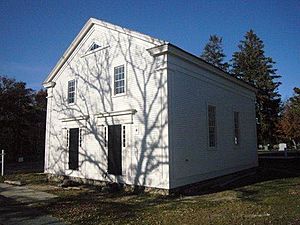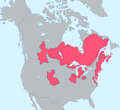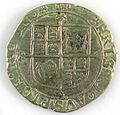Massachusett language facts for kids
Quick facts for kids Massachusett |
||||
|---|---|---|---|---|
| Wampanoag Massachusee unnontꝏwaonk Mâsach8see unôt8âôk (Muhsachuweesee unôtuwâôk) Wôpanâôtuwâôk |
||||
| Pronunciation | ||||
| Native to | United States | |||
| Region | Eastern Massachusetts, southeastern New Hampshire, and northern and southeastern Rhode Island | |||
| Ethnicity | Massachusett, Wômpanâak (Wampanoag), Pawtucket (Naumkeag, Agawam), Nauset, and Coweset. Neighboring Algonquian peoples as a second language. | |||
| Extinct | Late 19th century (possibly around 1890) | |||
| Language family |
Algic
|
|||
| Writing system | Latin script | |||
| Linguist List | wam | |||

The location of the Massachusett/Wampanoag tribe and their neighbors, c. 1600
|
||||
|
||||
The Massachusett language is an Algonquian language from the Algic language family. It was once spoken by many Native American groups in eastern Massachusetts. Today, it is being brought back to life by four communities of Wampanoag people. You might also hear it called Natick or Wôpanâak.
This language is special because many Native Americans learned to read and write it. Also, many religious books were translated into Massachusett. For example, John Eliot translated the Christian Bible into the Natick dialect in 1663. This was the first Bible ever printed in the Americas! It was also the first Bible translated by someone who wasn't a native speaker, and one of the first Bibles translated into a language that had never been written down before.
Native American teachers and ministers taught others how to read and write the language. This helped many people in their communities learn to read. We know this because there are many old court papers, church records, letters, and notes in books written in Massachusett from that time.
The Massachusett language was spoken by different groups in southern New England. This included areas in eastern Massachusetts, southeastern New Hampshire, and eastern Rhode Island. It was also often used as a second or third language across most of New England. Some Nipmuc and Pennacook people also started using it, especially in special Christian communities called "praying towns."
In 1993, a project began to bring the language back. It's called the Wôpanâak Language Reclamation Project (WLRP), started by Jessie Little Doe Baird. This project has successfully brought the Wampanoag dialect back to the Aquinnah, Mashpee, Assonet, and Herring Pond tribes. Now, some children are growing up speaking Massachusett as their first language, which hasn't happened in over a hundred years!
Contents
Understanding the Massachusett Language
The Massachusett language belongs to the Eastern branch of the Algonquian languages. These languages were spoken from eastern Canada all the way down to the Carolinas. Within the Eastern group, Massachusett is part of the Southern New England Algonquian (SNEA) languages. This group includes languages like Narragansett and Nipmuc.
How Massachusett is Different
One key way Massachusett stands out from other Southern New England Algonquian languages is how it uses the sound "n." For example, in Massachusett, the word for "dog" is annum. But in Narragansett, it's ayim, and in Nipmuc, it's alum. This difference helps experts tell the dialects apart.
| Proto-Algonquian | Massachusett (N-dialect /n/) |
Narragansett (Y-dialect /j/) |
Nipmuc (L-dialect /l/) |
Mohegan-Pequot (Y-dialect /j/) |
Quiripi (R-dialect /r/) |
English |
|---|---|---|---|---|---|---|
| *aθemwa | annum (anum) |
ayimp | alum | ayumohs | arum | dog |
| *aθankwa | anogqus (anôqees) |
anóckqus | alag8s | ayôqs | arráks | star |
| *rōtēw (PEA) | nꝏht (n8ht) |
yòte | l8te | yoht | ruht | fire |
Names of the Language
Native Americans traditionally called their language hettꝏonk (hutuwôk), which means "that which they can speak to each other." If a language was hard to understand, they called it siogontꝏwaonk (sayakôtuwâôk), meaning "difficult language."
During colonial times, the language was often called Massachusett unnontꝏwaonk, meaning "language of the Massachusett region," or Massachusee unnontꝏwaonk, "language of the Massachusett people." The name "Massachusett" comes from a sacred hill, now known as Great Blue Hill. It means "big," "sacred," or "great hill."
Today, the Wampanoag tribes involved in bringing the language back call it Wôpanâôtuwâôk, or "Wampanoag language." This name means "language of the easterners" or "language of the people of the dawn."
English settlers first called it the "Indian language." Later, "Massachusett" and "Natick" became common names. In Plymouth Colony, "Wampanoag" was also used. These three names are still the most common today.
Where the Language Was Spoken
Until the late 1600s, Massachusett was an important local language. A simpler version, called Massachusett Pidgin, was used as a common language for trade and communication across New England.
As a native language, its different forms were spoken by several groups living along the coast of Massachusetts and parts of Rhode Island and New Hampshire. However, many Native Americans died from diseases brought by Europeans, and they lost land to the growing number of English settlers. After King Philip's War, the language and its speakers were limited to smaller areas, mainly in the former praying towns of Natick and Ponkapoag, and on the islands of Martha's Vineyard and Nantucket.
By the 1800s, the language had mostly disappeared from Massachusett-speaking communities. The very last speakers died on Martha's Vineyard by the end of the 19th century.
Today, people are speaking the language again in four communities on Cape Cod and the nearby areas: Mashpee, Aquinnah, Freetown, and Cedarville, Plymouth. These are home to the Mashpee and Aquinnah tribes, who are part of the Wôpanâak Language Reclamation Project.
Massachusett Pidgin English
When English settlers arrived, some Native Americans already knew a little English. People like Samoset and Tisquantum could speak with the Pilgrims. As more English settlers came, English became more common. Native Americans started using a mix of English and Massachusett, which became known as Massachusett Pidgin English.
This pidgin language had mostly English words, but it also included many Massachusett words and grammar rules. For example, instead of saying "food" in Massachusett, they might say meechin, which came from the Massachusett word metsuwonk. They also used "me" for both "I" and "me."
This pidgin language helped spread many Native American words into English, like "wigwam" (for a house) and "sagamore" (for a chief). Over time, as Native Americans learned more English, Massachusett Pidgin English slowly blended into the local English spoken in New England.
History of the Language
Early History
The Massachusett language has a very long history. Its roots can be traced back to a language called Proto-Algic, spoken thousands of years ago in the Northwest Plateau region (near the Columbia River). Over time, groups of people moved east, and their languages changed. Around 1000 BC, Proto-Algonquian, the ancestor of the Algonquian languages, spread across North America.
Around 1000 AD, Proto-Eastern Algonquian developed in what is now southern Ontario and spread south to North Carolina. Later, around 1300 AD, Proto-Southern New England Algonquian (PSNEA) developed. This happened as people started farming more and using coastal resources. These changes led to larger populations and more settled communities. By the late 1500s, the languages, people, and ways of life would have been familiar to the first Europeans visiting the coast.
Colonial Period and Translations
When English settlers arrived in the 1600s, they founded Plymouth Colony (1620) and Massachusetts Bay Colony (1629) in Massachusett-speaking areas. The colonists relied on Native Americans to survive. As more English people arrived, efforts began to make Native Americans adopt European ways.
Missionaries like John Eliot learned the local languages and tried to convert Native Americans to Christianity. Eliot started "praying towns" where Native Americans were encouraged to live like Europeans, practice Christianity, and follow colonial laws. In 1663, Eliot printed his famous Bible translation in Massachusett. Native Americans in the praying towns began to use this written language.
After Eliot's death, other missionaries continued his work. Experience Mayhew, who grew up on Martha's Vineyard and spoke the language fluently, created popular translations. Native Americans continued to read and write in Massachusett until the late 1700s.
Native American Teachers and Literacy

Many Native American translators and interpreters helped Eliot and other missionaries. People like Job Nesutan, John Sassamon, and James Wawâus Printer were very skilled in reading and writing. James Printer even learned how to use the printing presses!
These Native American leaders helped spread Christianity and literacy. Within 20 years of Eliot's first printed books, about one in three Native Americans in the Massachusetts Bay and Plymouth colonies could read and write Massachusett. These literate Native Americans became important leaders in their communities, serving as teachers, ministers, and town officials.
Literacy remained important until the 1770s. However, as younger generations started using English more, and Native American communities faced challenges like war and land loss, the use of the language slowly declined.
Why the Language Disappeared
The written language became less common during the 1700s. The last town records in Massachusett were written in Natick in 1720. The last known document in the language was a marriage record from 1771.
The spoken language lasted longer, especially in isolated Wampanoag communities on Martha's Vineyard and Nantucket. On Nantucket, the last speaker, Dorcas Honorable, died in 1855. On Martha's Vineyard, the language survived even longer, with some speakers possibly living into the late 1800s.
Several things caused the language to disappear:
- Diseases: Many Native Americans died from diseases like smallpox and measles brought by Europeans. This greatly reduced the number of speakers.
- Wars: King Philip's War (1675–76) killed many Native Americans and forced others to flee or be sold into slavery. Later wars also took a toll on the population.
- Loss of Land: As Native Americans lost their land, they could no longer support themselves through farming. Men had to find jobs in cities, and women worked in English households. This made it harder to keep their language alive.
- Assimilation: As English settlers outnumbered Native Americans, there was pressure to learn English and adopt English customs. Intermarriage with non-Native people also led to fewer children learning the language.
Bringing the Language Back

Even after the language stopped being spoken, many Massachusett documents remained. These included land sales, letters, and religious books. These old records became very important for bringing the language back.
In 1903, the Natick Dictionary was published, which helped researchers understand the language's words. Later, experts like Ives Goddard and Kathleen Bragdon studied Native American writings. They also used other related Algonquian languages to help fill in missing parts of the grammar and pronunciation.
In 1993, Jessie Little Doe Baird of the Mashpee Wampanoag tribe co-founded the Wôpanâak Language Reclamation Project (WLRP). She studied at Massachusetts Institute of Technology (MIT) and worked with linguists to reconstruct the language. In 2000, she published her master's thesis, "Introduction to Wampanoag Grammar." The WLRP now includes people from the Aquinnah, Herring Pond, and Assonet tribes.
It's said that the language's revival fulfills an old Wôpanâak prophecy. Jessie Little Doe Baird is a direct descendant of Nathan Pocknett, who resisted conversion, while one of her mentors, Kenneth Hale, was a direct descendant of missionary Roger Williams.
Current Status of the Language
In 2010, Jessie Little Doe Baird received a special award for her language revival efforts. A documentary called Âs Nutayanyean-We Still Live Here (meaning "We Still Live Here") was also made about her work.
By 2014, the Wôpanâak Language Reclamation Project had achieved amazing things. A few children were growing up as native speakers, the first in over a century! There were also 15 fluent speakers and hundreds of adults learning the language. The project has created a dictionary with about 12,000 words and developed teaching materials.
The WLRP continues to offer language classes, summer camps, and after-school programs for the four tribes involved. In 2016, they opened Mukayuhsak Weekuw ("Children's House"), a language immersion school for children. This school helps young people learn the language in a fun and natural way.
The Wampanoag people have also spoken out about how their language and culture are shown in media. For example, they objected to parts of the National Geographic mini-series Saints & Strangers (2015) because they felt the language and cultural details were not accurate. They stressed that using a different Algonquian language, like Abenaki, was like saying "Portuguese is Spanish." This shows how important it is to use the correct language and respect each tribe's unique identity.
Massachusett Words in English

When English settlers first came to New England, they depended on Native Americans for survival. Through these interactions, the English adopted many Native American words, especially from the Massachusett language. These words were sometimes called "wigwam words," with "wigwam" coming from the Massachusett Pidgin word for "house" or "home."
Many common English words come from Massachusett or related Algonquian languages:
- papoose: Originally referred to Native American children.
- squash: A shortened form of words like askꝏtasquash.
- moccasin: A type of shoe.
- moose: A large animal.
- skunk: A small, smelly animal.
- muskrat: A rodent that lives in water.
- samp: A type of corn porridge.
- quahog: A hard-shelled clam.
- succotash: A dish made of beans and corn.
- sachem: A tribal chief.
- powwow: Originally referred to a shaman or healer, now means a Native American gathering.
- tomahawk: A type of axe or hatchet.

Many of these words were borrowed from Massachusett Pidgin, which was a simpler form of the language used for communication. For example, English settlers used "sagamore" and "sachem" interchangeably for tribal leaders. "Sagamore" likely came from Massachusett Pidgin, while "sachem" came from the proper Massachusett word.
Over time, some of these "wigwam words" changed their meaning or became used in negative ways, especially during westward expansion. For example, "squaw," which simply meant "female" in Massachusett, became an insult. This shows how important it is to understand the true origins and meanings of words.
Place Names from Massachusett
Many places in eastern Massachusetts have names that come from the Massachusett language. The name of the state itself, "Massachusetts," might mean "near the big hill" or "hill shaped like an arrowhead."
Here are some cities and towns with Massachusett origins:
- Acushnet (meaning "calm water resting place")
- Aquinnah ("under the hills")
- Cohasset (quonnihasset, "long fishing point")
- Mashpee (massanippe, "great water")
- Nantucket ("in the midst of the waters")
- Natick ("place of hills")
- Saugus ("the outlet, the extension")
- Scituate ("cold brook")
- Seekonk ("Canadian goose")
- Swampscott ("at the red rock" or "broken waters")
Other notable place names include "Shawmut" (an old name for Boston, meaning "canoe landing place") and "Mystic River" ("great river").
Images for kids
-
Counterfeit shilling from the reign of Charles I (reverse). Use of English currency led to the words moneash ('money'), pence, shillings, and pay- as a verbal root for 'pay.'
-
Tautogolabrus adspersus, also called 'chogset' (Massachusett chohkesit (chahkusut), 'it is blemished' or 'it is spotted').
-
John Eliot preaching to Indians.
See also
 In Spanish: Idioma massachusett para niños
In Spanish: Idioma massachusett para niños









